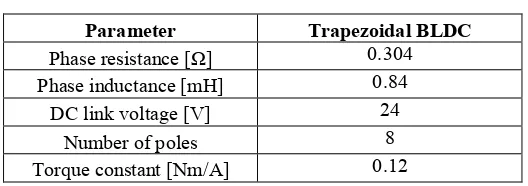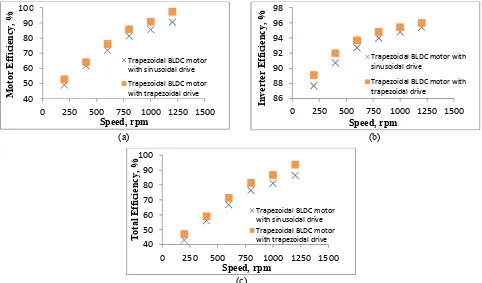Efficiency Comparison of Trapezoidal and Sinusoidal Method for
Brushless DC Motor Drive
Mohd Arif Abu Hassan
1, a,
Abdul Rahim Abdullah
2,b,
Nurhazilina Bahari
3,cand Muhammad Ihsan Mohd Sabri
4,d1,2,3,4 Universiti Teknikal Malaysia Melaka, Hang Tuah Jaya, 76100 Durian Tunggal, Melaka, Malaysia
a[email protected], b[email protected], c[email protected], d[email protected]
Keywords: Brushless DC motor, trapezoidal back-emf, pulse width modulation, trapezoidal drive, sinusoidal drive, efficiency.
Abstract. This paper compares overall efficiency of trapezoidal BLDC motor which is excited by
trapezoidal drive and sinusoidal drive. The different characteristics and performance of trapezoidal brushless DC (BLDC) motor is formed by driving methods. Sinusoidal drive that excites trapezoidal BLDC motor generates greater maximum torque than trapezoidal drive. However, with regard to high frequency loss caused by a pulse width modulation (PWM) carrier and switching loss, the trapezoidal drive has potential to achieve higher efficiency than the sinusoidal drive. Thus, these two drive methods excite trapezoidal BLDC motor are compared to study the performance of efficiencies. The motors drives are simulated by using MATLAB and their efficiencies are measured. The results show that the trapezoidal BLDC motor with trapezoidal drive has higher efficiency compared to trapezoidal BLDC motor with sinusoidal drive.
Introduction
Recent years, brushless DC (BLDC) motor has been taken over in variety of consumer electric appliances because of high efficiency and low maintenance [1]. The BLDC motor can be excited by trapezoidal drive and sinusoidal drive. Sinusoidal drive that excites BLDC motor generates greater maximum torque than trapezoidal drive [2]. However, with regard to high frequency loss caused by a pulse width modulation (PWM) carrier and switching loss, the trapezoidal drive has potential to achieve higher efficiency than the sinusoidal drive [3]. Therefore, the combination of BLDC motor with trapezoidal drive is proposed and then its efficiency is compared to BLDC motor with sinusoidal drive.
The different characteristics and performance of these motors are formed by their driving methods. Previous research compared trapezoidal and sinusoidal drive and reported at view point of the characteristic with flux weakening region [4]. However, this research did not determine the efficiency. On other hand, the loss and efficiency comparison of trapezoidal and sinusoidal drives are reported but only for sinusoidal BLDC motor [5]. Other research also reported the comparison of switching scheme trapezoidal BLDC motors but this research only present current waveforms and torque ripple analysis [6]. However, these previous paper are able to support the validity of this study.
The BLDC motor is classified into trapezoidal type and sinusoidal type which the motor respectively has sinusoidal back-emf and trapezoidal back-emf. In this paper, the 24V trapezoidal BLDC motor is studied for different simple drive methods. The 24 V BLDC motor is choose for reason of lower power consumption application. This paper mainly show the system efficiency of trapezoidal BLDC motor which are excited by trapezoidal and sinusoidal drive respectively. The simulation tests are carried out under the actual driving condition at variable speed.
Comparative Study between Trapezoidal and Sinusoidal Drive
Conduction Mode. In the case of trapezoidal drive, only two phases motor terminal are excited at a
time [7,8]. The phase currents conduction for trapezoidal drive is shown in Fig 1(a). Phase A and B
Applied Mechanics and Materials Vol. 785 (2015) pp 248-252 Submitted: 2014-12-03
© (2015) Trans Tech Publications, Switzerland Revised: 2015-03-24
doi:10.4028/www.scientific.net/AMM.785.248 Accepted: 2015-04-04
are conducted in same conduction interval, meanwhile the phase C is disconnected. For electric cycle, each commutation occurs every 60 electrical degree and conducting interval for each phase is 120 electrical degree. In contrast, sinusoidal drive conducts 180 electrical degree of conducting interval for each phase [6]. The three phase currents conduction for sinusoidal drive is shown in figure 1 (b). Phase A, B and C are conducted in the same interval because the current respectively flows from phase A to phase B and phase C to phase B.
(a) (b)
Fig. 1: Current flow (a) trapezoidal drive (b) sinusoidal drive
Switching Sequence. In each 60 electrical degree, trapezoidal drive conducts “ON” only for two
transistors meanwhile sinusoidal drive conducts “ON” for three transistors. The conduction of two transistors performs two conduction phases and conduction of three transistors performs three conduction phases. Method to conducts two phases at instant time is easier to be implemented compared to method that conducts three phases [3,6]. The switching sequences for trapezoidal and sinusoidal drive are summarized in Table 1. This table clearly presents the conduction phases for each 60 electrical degree respective to “ON” state of transistors.
Table 1: Switching sequences of trapezoidal and sinusoidal drive
Interval (Degree)
Switching Sequences
Trapezoidal Commutation Sinusoidal Commutation Transistor
“ON” A B C Polarities Transistor “ON” Polarities A B C 0-60 T1,T6 + 0 - T1,T6,T5 + - + 60-120 T3,T6 0 + - T1,T6,T2 + - - 120-180 T3,T2 - + 0 T1,T3,T2 + + - 180-240 T5,T2 - 0 + T4,T3,T2 - + - 240-300 T5,T4 0 - + T4,T3,T5 - + + 300-360 T1,T4 + - 0 T4,T6,T5 - - +
The Proposed Trapezoidal Drive Method
In this paper, unipolar PWM is used to regulate motor terminal average voltage [8]. Switching state of transistors are turned on and off at a chopper frequency. However, only upper level transistors are applied PWM (chopping mode) within 120 electrical degree and the lower level transistors are leaving “ON” during the active conduction interval. By compare to other general PWM techniques, this technique has a characteristic of minimum current pulsation and also being determined as the simplest technique that can be applied [7]. This trapezoidal drive applies chopping for only one switch. In contrast, sinusoidal applies chopping mode for all three turned “ON” switches. This fact gives an assumption that the trapezoidal drive will have higher inverter efficiency compared to sinusoidal drive because it performs with lower switching loss [3].
Trapezoidal and Sinusoidal Drive Performance
Motor Efficiency. The PWM effects contribute to current and voltage harmonics. These two harmonics can increase motor losses. Increasing of the losses will cause to reduction of motor efficiency. The motor efficiency can be determined by the following equation.
A Q1 Q3 Q5
Q2 Q4 Q6
A
Q1 Q3 Q5
Q2 Q4 Q6
= ×100[%]
respectively. IrmsVrms and Tmωmrespectively from input motor power and output motor power.
Inverter Efficiency. The inverter efficiency is also analyzed to compare the inverter performance
between the trapezoidal and vector control drive. The inverter efficiency can be calculate by using
= ×100[%]
In this section, efficiencies of simulation drives are shown to verify the systems performance. Table 2 shows the parameters of the tested motors. The motors are investigated under variable speed
Motor Current Waveform and Speed Response. The motor current waveforms for trapezoidal
and sinusoidal drive are shown in Fig. 2(a) and 2(b). The trapezoidal drive conducts quasi-square current waveform because the BLDC motor has trapezoidal back-emf meanwhile the sinusoidal drive conducts non-zero square current waveform.
Fig. 3(a) and 3(b) respectively show the current and speed response for trapezoidal and sinusoidal drive. From the results of current waveforms and speed responses, it can be observed that the phase currents decrease respectively to the speed step change because the average current supply is modulated to control the motor speed. The motor speed smoothly rises up and slow down to steady state condition corresponding to the excitation phase current.
(a) (b)
Fig. 2: Current waveform (a) trapezoidal shape, (b) sinusoidal shape.
(a) (b)
Fig. 3: Current and speed response (a) trapezoidal drive, (b) vector control drive.
Efficiency Comparison. Fig. 4 shows measured efficiency from motor drive simulation. Fig. 4(a)
shows trapezoidal BLDC motor with trapezoidal drive has higher motor efficiency at all speed region. The motor have small different efficiency at low speed region and become larger by increasing of speed. From the efficiency behavior, it shows that the trapezoidal drive generates much torque ripple at lower speed. However, the PWM carrier effect is effectively suppressed by trapezoidal drive at all speed regions and offers higher efficiency. Fig. 4(b) shows the inverter efficiency of both drives. As expected, the inverter efficiency of trapezoidal drive is higher than sinusoidal drive under all speed regions. Thus, it is verified that trapezoidal drive has low inverter loss.
The results from motor and inverter efficiency are used to estimate total efficiency in Fig. 4(c). The simulation measurement shows the BLDC motor with trapezoidal drive has the highest total efficiency among this motor and drives combination. These results can be considered as proper verification because it also supported by previous research.
(a) (b)
(c)
Fig. 4: Measured efficiency from simulation (a) motor efficiency, (b) inverter efficiency, (c) total efficiency
0 250 500 750 1000 1250 1500
M
0 250 500 750 1000 1250 1500
In
0 250 500 750 1000 1250 1500
To
Conclusion
This paper presents measured efficiencies from simulation of trapezoidal BLDC motor driven by trapezoidal and sinusoidal drive. The trapezoidal drive offers higher efficiency at all speed regions as the PWM carrier effect is effectively suppressed from low to high speed. The BLDC motor with trapezoidal drive also has the highest inverter efficiency as it assumed to has the lowest switching loss because trapezoidal drive apply chopping signal for only one switch. Therefore, the developed trapezoidal drive with trapezoidal BLDC motor has the highest total efficiency in the motor and drive combination. These results give a considerable to select trapezoidal BLDC motor with trapezoidal drive to be applied in low cost application for energy consumption and drive performance improvement.
Acknowledgements
The authors would like to thank Universiti Teknikal Malaysia Melaka (UTeM) for its financial support Malaysia for providing the resources for this research (ERGS/1/2013/TK02/UTEM/02/02).
References
[1] N.B. Bahari, A. Jidin, A.R. Abdullah, M.N. Othman, M. Manap, Modeling and simulation of torque hysteresis controller for brushless DC motor drives, Industrial Electronics and Applications (ISIEA), 2012 IEEE Symposium on , vol., no., pp.152,155, 23-26 Sept. (2012) [2] Boyang Hu, S. Sathiakumar, Sensorless drive of permanent magnet brushless DC motor with
180 degree commutation, Robotics Automation and Mechatronics (RAM), 2010 IEEE Conference on , vol., no., pp.106,111. (2010)
[3] M. Miyamasu, K. Akatsu, Efficiency comparison between Brushless dc motor and Brushless AC motor considering driving method and machine design, IECON 2011 - 37th Annual Conference on IEEE Industrial Electronics Society, pp.1830,1835. (2011)
[4] Z.Q. Zhu, J.X. Shen, D. Howe, Flux-weakening characteristics of trapezoidal back -emf machines in brushless DC and AC modes, Proc. Int. Power Electronics and Motion Control Conf., IPEMC, (2006), Shanghai, China.
[5] G. Liu, W.G. Dunford, Comparison of sinusoidal excitation and trapezoidal excitation of a brushless permanent magnet motor, Power Electronics and Variable-Speed Drives, 1991., Fourth International Conference, pp.446,450. (1991)
[6] Boyang Hu, S. Sathiakumar, Y. Shrivastava, 180-Degree Commutation System of Permanent Magnet Brushless DC Motor Drive Based on Speed and Current Control, Intelligent Computation Technology and Automation, 2009. ICICTA '09. Second International Conference on , vol.1, no., pp.723,726, 10-11 Oct. (2009)
[7] Y. S. Lai, F. S. Shyu, and Y. K. Lin, Novel PWM technique without causing reversal DC-link current for brushless DC motor drives with bootstrap driver, in Proc. of IEEE IAS, Vol.3, pp. 2182-2188. (2005)
[8] M.A.A. Hassan, A.R. Abdullah, N. Bahari Speed Control Analysis of Brushless DC Motor Based on Maximum Amplitude DC Current Feedback. MATEC Web of Conferences, 13 . 03007p1-03007p6. ISSN 2261-236X. (2014)


